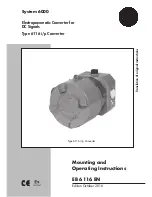
3 Set-up and installation
17
FA ROTEX ESU - 07/2008
External temperature sensor
• Choose a location at about one third of the building height (minimum distance from floor: 2 m) on the coldest side of the
building (north or north-east).
• Ensure that the location is not near to any external heat sources (flues, air ducts), nor subject to direct solar radiation.
• Place external temperature sensors in such a way that the cable exit points face downwards (prevents humidity ingress).
• Connect the outdoor temperature sensor with a duplex wire (minimum cross-section
1 mm
2
) with the cable marked "outdoor
temperature sensor".
Mixer circuit flow sensor (accessory)
• Connect the sensor line to the sensor plug
J8
(see Figure 3-5, page 16).
3.8
Optional connections
3.8.1 Mixer circuit
A mixer circuit, which is controlled via the electronic boiler control, can be connected to the ROTEX ESU
directly
.
ROTEX offers the following:
– The
AMK1 (
15 60 44)
mixer group, which is ready to plug in and consists of a circulation pump integrated into a heat-
insulated housing, a motor mixer and stop valves with temperature indicators.
– The
TMKF (
15 60 62)
mixer circuit docking sensor.
3.8.2 Room thermostat
To remotely set the room temperature from another room, a separate room thermostat
ROTEX
ALPHA RTR-E (
17 51 26)
can be installed for the direct or the mixed circuit. If you want to use this function, you must activate it in the
ROTEX ALPHA
+
23R control.
– Connection of the room thermostat
ROTEX ALPHA RTR-E
to the terminal AB of the board connector
J8
on main unit
3.9
Filling the system
Adjusting the pressure gauge
Before filling the system for the first time, the minimum pressure marking must be adjusted to the correct setting on the pressure
gauge glass:
• Rotate the pressure gauge glass (Figure 2-1, page 8, pos. 30) so that the minimum pressure marking equates to the
height
of the 2 m
(1 m water column corresponds to 0.1 bar).
Once all installation work has been completed, fill the ROTEX E-SolarUnit by following the sequence below:
1. Filling the hot water heat exchanger
• Open the shutoff valve for the cold water supply pipe.
• Open the hot water bleeder tap connections so that the draw-off volume can be set as high as possible.
• Once water has been discharged from the tap connections, do not interrupt the cold water inflow; this will ensure that the
heat exchanger will be fully vented and that any impurities or residue will be discharged.
CAUTION!
Laying the sensor and mains lines in parallel within a wiring conduit can lead to major malfunctions during
controlled operation of the ROTEX ESU.
• Always lay the sensor line separately.
Содержание E-Solar Unit ESU 509
Страница 70: ...14 Notes 70 FA ROTEX ESU 07 2008...
















































